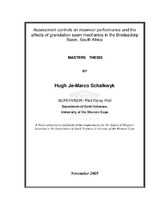Assessment controls on reservoir performance and the affects of granulation seam mechanics in the Bredasdorp Basin, South Africa
Abstract
The Bredasdorp Basin is one of the largest hydrocarbon producing blocks within Southern Africa. The E-M field is situated approximate 50 km west from the FA platform and was brought into commission due to the potential hydrocarbons it may hold. If this field is brought up to full producing capability it will extend the lifespan of the refining station in Mosselbay, situated on the south coast of South Africa, by approximately 8 to 10 years. An unexpected pressure drop within the E-M field caused the suite not to perform optimally and thus further analysis was imminent to assess and alleviate the predicament. The first step within the project was to determine what might have cause the pressure drop and thus we had to go back to cores drilled by Soekor now known as Petroleum South Africa, in the early 1980’s.
Analyses of the cores exposed a high presence of granulation seams. The granulation seams were mainly subjected within sand units within the cores. This was caused by rolling of sand grains over one another rearranging themselves due to pressure exerted through compaction and faulting, creating seal like fractures within the sand. These fractures caused these sand units to compartmentalize and prohibit flow from one on block to the next. With advance inquiry it was discovered that there was a shale unit situated within the reservoir dividing the reservoir into two main compartments. At this point it was determined to use Petrel which is windows based software for 3D visualization with a user interface based on the Windows Microsoft standards. This is easy as well as user friendly software thus the choice to go with it. The software uses shared earth modeling tool bringing about reservoir disciplines trough common data modelling. This is one of the best modelling applications in the available and it was for this reason that it was chosen to apply within the given aspects of the project A lack of data was available to model the granulation seams but with the data acquired during the core analyses it was possible to model the shale unit and factor in the influences of the granulation seams to asses the extent of compartmentalization. The core revealed a thick shale layer dividing the reservoir within two sections which was not previously noted. This shale layer act as a buffer/barrier restricting flow from the bottom to the top halve of the reservoir. This layer is thickest at the crest of the 10km² domal closure and thins toward the confines of the E-M suite. Small incisions, visible within the 3 dimensional models could serve as a guide for possible re-entry points for future drilling. These incisions which were formed through Lowstand and Highstand systems tracts with the rise and fall of the sea level. The Bredasdorp Basin consists mainly of tilting half graben structures that formed through rifting with the break-up of Gondwanaland. The model also revealed that these faults segregate the reservoir further creating bigger compartments. The reservoir is highly compartmentalized which will explain the pressure loss within the E-M suite. The production well was drilled within one of these compartments and when the confining pressure was relieved the pressure dropped and the production decrease. As recommendation, additional wells are required to appraise the E-M structure and determine to what extent the granulation seems has affected fluid flow as well as the degree of sedimentation that could impede fluid flow. There are areas still containing untapped resources thus the recommendation for extra wells.

